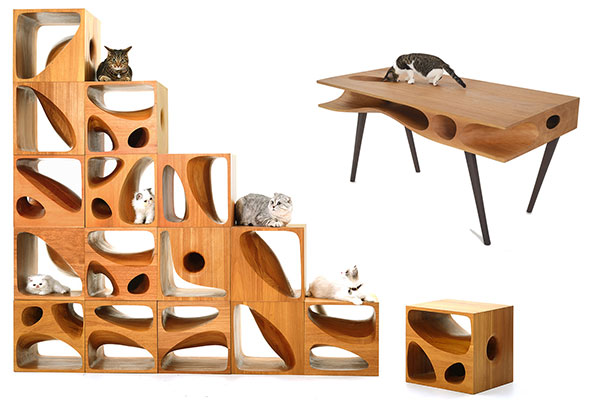
CATable 1.0 (Top right) and CATable 2.0 are designed by Ruan Hao as a second home for cats, with many inbuilt crevices in which the pets can play, crouch or sleep.[Photo/Provided to China Daily]
Architect designs furniture to help you stay close to your pet, Lin Qi reports.
Cat lovers, your beloved fluffy companions could stay by your side while you work, thanks to home furniture designed by Hangzhou-based architect Ruan Hao.
Calling it CATable, Ruan, 30, got a lot of attention when an online video of his concept desk went viral.
Other than serving as a workplace for owners, CATable can become a second home for cats, with its many inbuilt crevices in which the pets can play, crouch or sleep.
But Ruan doesn’t reveal when the CATable will be on the market in China, saying it is a “business secret”. His team may also be thinking of a future series of such tables.
“Right now we don’t know exactly what we will attempt to create. But we promise that it will be as interesting as CATable.”
Ruan, a cat owner who founded LYCS Architecture in 2010, has several awards to his credit for designing schools, commercial compounds and office interiors. The idea for CATable came to him when he was thinking of ways to change the look of a normal table. He wanted to make space for the pleasure of both owners and their cats, and found that adding drawers wasn’t the solution.
“When someone sits by a desk, the distance between the surface and the person’s lap is about 20 centimeters. The space in between can be transformed into a ‘room’ of fun,” Ruan tells China Daily.
He describes the relationship between an owner and his or her cat as subtle.
“You want to spend as much time with your cat as possible. But when you need to get back to work or study, and push your cat away from your lap, it’s an emotional moment.”
Ruan’s first version CATable 1.0 was difficult to manufacture because the design involved irregular cuts in the wood with which the desk is made. Ruan and his team first made a model with the help of 3-D imaging, and presented a printout to the craftsmen, asking them to carve one desk out of an entire block of wood.
“It doesn’t look good if the table is made up of wooden joints,” Ruan says.
Then carpenters drilled tunnels and pockets into the table and polished every part of it. The process preserves both the natural feel of wood and the sophistication of the handicraft.
Before he designed the CATable, Ruan researched feline behavior. But still, he was nervous when three or four cats were brought to his office to try out the table. He and his team weren’t sure if the cats would venture into the tunnels to play, he says. But they loved the table.
“Cats are agile and have elastic bones. So, it is unlikely that they will get stuck in the table.”
The other benefit of having a cat on your work desk or study table is the ease of cleaning. Cats tend to clean themselves often through the day and the owners can just use a hair dryer to remove fallen fur from the furniture, he adds.
CATable was exhibited at Milan Design Week 2014 along with the works of other Chinese designers.
“The table may cater to only a small group of people right now. But as long as they like it, they will help talk about it to a larger population,” Ruan says.
The table comes in another version.
Earlier this year, Ruan updated the design by creating CATable 2.0. He felt that a cat may get bored with CATable 1.0, just like people lose interest in objects they use daily.
Ruan found inspiration from toy blocks that children spend hours assembling.
CATable 2.0 is made of several wooden cube modules. Each cube, measuring some 40 centimeters in height, has cavities of varying shapes and sizes. People can group the cubes in the same way a child piles up toy blocks. The combinations create different walking routes for cats, and allows owners to turn the units into shelves, desks or other furniture.
“CATable 2.0 is not merely an improvement of 1.0. It has become an open system and users help complete the design. They can rearrange the modules to the utmost,” Ruan says.
“Design has become more cross-disciplinary. Whether we design a building, the interior space or furniture, we are all attesting to users’ emotional needs. We work with shared logic as long as our creation is about the city and life.”
